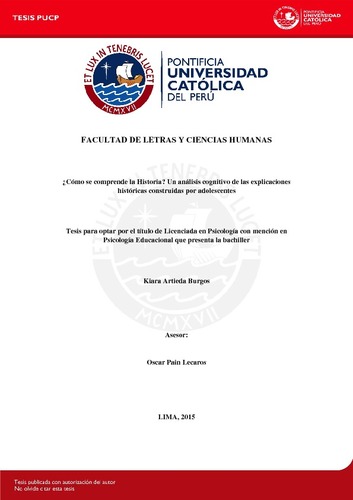| dc.contributor.advisor | Pain Lecaros, Oscar Andrés | es_ES |
| dc.contributor.author | Artieda Burgos, Kiara | es_ES |
| dc.date.accessioned | 2015-11-12T15:30:23Z | es_ES |
| dc.date.available | 2015-11-12T15:30:23Z | es_ES |
| dc.date.created | 2015 | es_ES |
| dc.date.issued | 2015-11-12 | es_ES |
| dc.identifier.uri | http://hdl.handle.net/20.500.12404/6395 | |
| dc.description.abstract | Desde las nuevas aproximaciones a la enseñanza y el aprendizaje de la Historia en la educación básica, la explicación histórica representa uno de los más importantes logros de aprendizaje. Esta investigación tuvo como objetivo caracterizar las explicaciones de estudiantes adolescentes frente a un hecho histórico ficticio. Los participantes fueron 16 alumnos de 2º y 5º de secundaria de dos instituciones educativas y dos coordinadores del curso de Historia. Se emplearon tres instrumentos: la prueba “La prosperidad de Tasmania” y dos guías de entrevista semiestructurada. Los resultados mostraron que los adolescentes de 2º de secundaria preferían factores causales para explicar el hecho histórico, mientras que los de 5º de secundaria preferían factores intencionales. Asimismo, revelaron que los adolescentes de 2º de secundaria no lograron establecer relaciones complejas entre los factores al explicar el hecho histórico; por el contrario, los participantes de 5° de secundaria sí lo hicieron. Del mismo modo, se encontraron diferencias en ambas instituciones educativas en la manera de aproximarse a la enseñanza de la Historia. Estos resultados podrían relacionarse con la habilidad de aprender Historia, basada en la consolidación de las operaciones formales y en los procesos de instrucción en la enseñanza de esta Ciencia Social. | es_ES |
| dc.description.abstract | In base of the new approaches to teach and learn History, historical explanation represents one of the most important learning objective. The aim of this study was to analyze history explanations given by a group of adolescent students about a fictitious historical fact. Participants were 16 students from 2nd and 5th grades of secondary school and two teachers from the History classes. Three measurements were used: “The Prosperity of Tasmania” and two semi-structured interviews. Results showed that 2nd grade students used causal factors to explain a historical fact. In contrast, 5th grade students used intentional factors to assess this fact. Also, 2nd grade students were not be able to establish relations between factors in order to explain a historical fact. Besides, 5th grade students were successful on establishing these relations. At the same time, results showed differences between schools' approach used to teach History. These evidence could be associated with the ability to learn history, based on the consolidation of formal operations, and with the instructional process of teaching history. | es_ES |
| dc.language.iso | spa | es_ES |
| dc.publisher | Pontificia Universidad Católica del Perú | es_ES |
| dc.rights | Atribución-NoComercial-SinDerivadas 2.5 Perú | * |
| dc.rights | info:eu-repo/semantics/openAccess | es_ES |
| dc.rights.uri | http://creativecommons.org/licenses/by-nc-nd/2.5/pe/ | * |
| dc.subject | Historia--Estudio y enseñanza (Secundaria) | es_ES |
| dc.subject | Aprendizaje (Educación). | es_ES |
| dc.subject | Cognición en la adolescencia | es_ES |
| dc.subject | Psicología del adolescente | es_ES |
| dc.title | ¿Cómo se comprende la historia? : un análisis cognitivo de las explicaciones históricas construidas por adolescentes | es_ES |
| dc.type | info:eu-repo/semantics/bachelorThesis | es_ES |
| thesis.degree.name | Licenciado en Psicología Educacional | es_ES |
| thesis.degree.level | Título Profesional | es_ES |
| thesis.degree.grantor | Pontificia Universidad Católica del Perú. Facultad de Letras y Ciencias Humanas | es_ES |
| thesis.degree.discipline | Psicología Educacional | es_ES |
| renati.discipline | 313046 | es_ES |
| renati.level | https://purl.org/pe-repo/renati/level#tituloProfesional | es_ES |
| renati.type | http://purl.org/pe-repo/renati/type#tesis | es_ES |
| dc.publisher.country | PE | es_ES |
| dc.subject.ocde | http://purl.org/pe-repo/ocde/ford#5.01.00 | es_ES |






